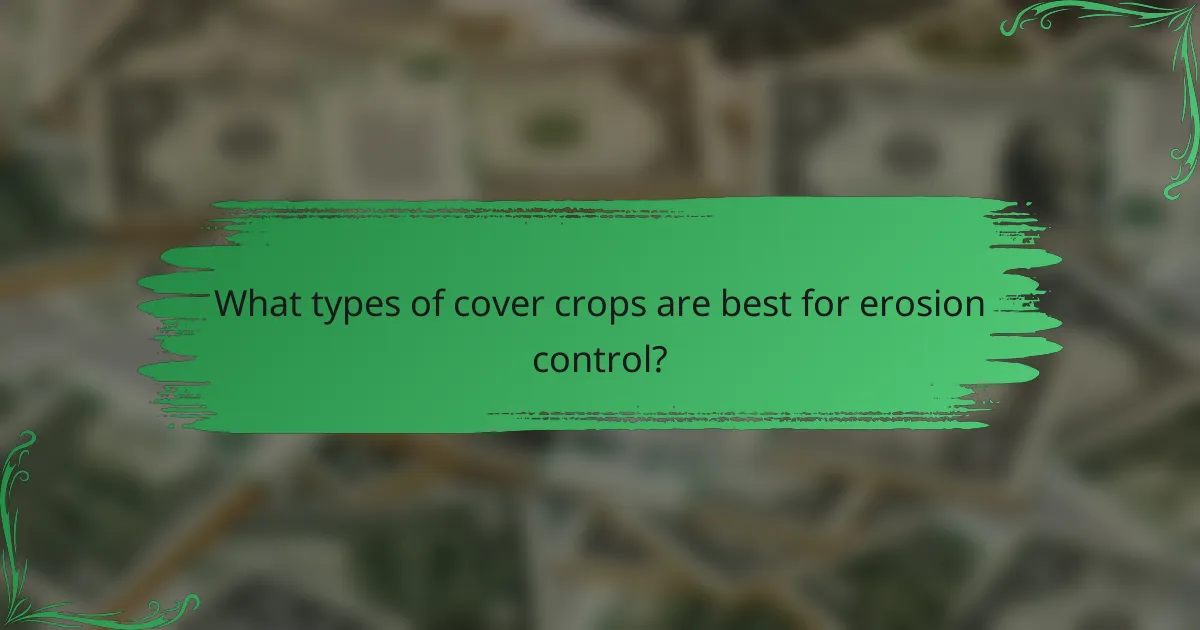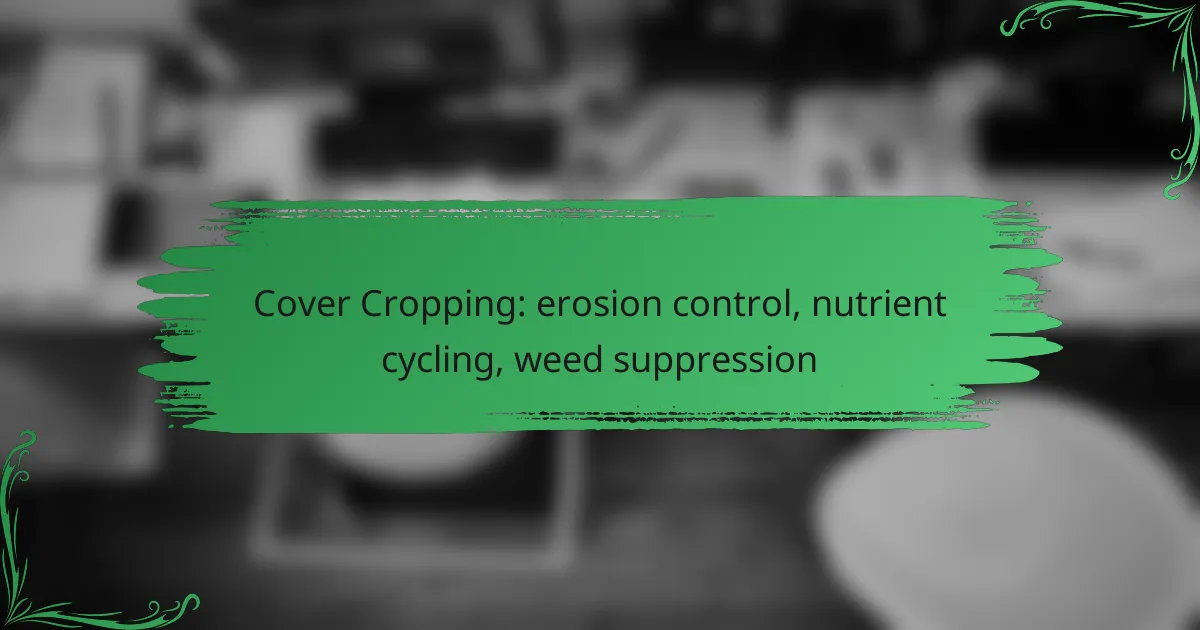Cover cropping is a vital agricultural practice that enhances soil health by controlling erosion, cycling nutrients, and suppressing weeds. By improving soil structure and stability, cover crops effectively reduce erosion risks while capturing and storing essential nutrients for future crops. Additionally, they outcompete weeds and create barriers that promote a healthier growing environment, making them an invaluable tool for sustainable farming.

How do cover crops control erosion in the Midwest?
Cover crops effectively control erosion in the Midwest by enhancing soil structure and stability. Their roots bind soil particles, reducing the risk of erosion caused by wind and water.
Root structure stabilization
The root systems of cover crops play a crucial role in stabilizing soil. Deep and fibrous roots penetrate the soil, creating a network that holds soil particles together. This structure is particularly beneficial in preventing soil displacement during heavy rainfall.
For instance, species like rye and clover develop extensive root systems that can reach depths of several feet. This not only anchors the soil but also improves its overall health by promoting microbial activity.
Soil moisture retention
Cover crops contribute to soil moisture retention by reducing evaporation and enhancing infiltration. Their foliage provides shade, which lowers surface temperatures and minimizes water loss from the soil.
Additionally, the organic matter from decomposed cover crops improves soil structure, allowing it to retain moisture more effectively. This is especially important in the Midwest, where seasonal droughts can impact crop yields.
Reduction of surface runoff
By covering the soil, cover crops significantly reduce surface runoff during rain events. This is achieved through their ability to slow down water flow and increase infiltration rates.
Practically, this means that less topsoil is washed away, preserving valuable nutrients. Implementing cover crops can lead to a reduction in runoff by up to 50%, depending on the crop type and local conditions.

What are the benefits of nutrient cycling with cover crops?
Nutrient cycling with cover crops enhances soil health by improving nutrient availability and reducing the need for synthetic fertilizers. These crops capture and store nutrients, which can then be released back into the soil, benefiting subsequent crops.
Improved soil fertility
Cover crops contribute to improved soil fertility by fixing nitrogen and enhancing the availability of essential nutrients. Leguminous cover crops, such as clover or vetch, can naturally increase nitrogen levels in the soil, which is crucial for plant growth.
Incorporating cover crops into your rotation can lead to higher yields in subsequent cash crops, as the nutrients released during decomposition support plant development. Regular use of cover crops can reduce the need for chemical fertilizers, saving costs in the long run.
Enhanced microbial activity
Cover crops promote enhanced microbial activity in the soil, which is vital for nutrient breakdown and availability. The roots of these crops exude organic compounds that serve as food for beneficial soil microbes, fostering a diverse and active soil ecosystem.
Increased microbial populations can improve nutrient cycling efficiency, leading to better nutrient uptake by plants. This symbiotic relationship between cover crops and soil microbes helps maintain soil health and resilience against pests and diseases.
Increased organic matter
Using cover crops leads to increased organic matter in the soil, which improves soil structure and moisture retention. As cover crops grow and decompose, they add organic material that enhances soil aeration and drainage.
Higher organic matter levels can improve soil fertility and support a wider range of soil organisms. Aim for a mix of cover crops that can contribute different types of organic matter, such as grasses for bulk and legumes for nitrogen, to maximize benefits.

How do cover crops suppress weeds effectively?
Cover crops suppress weeds by outcompeting them for resources, creating physical barriers, and releasing natural chemicals that inhibit weed growth. These methods collectively reduce weed populations and improve soil health, making cover cropping a valuable practice for sustainable agriculture.
Competitive growth
Cover crops grow rapidly and establish a dense canopy that limits sunlight and space available for weeds. By occupying the same resources—such as water, nutrients, and light—cover crops can significantly reduce the growth of unwanted plants. Selecting fast-growing species can enhance this competitive advantage.
For effective weed suppression, choose cover crops that are well-suited to your local climate and soil conditions. Common options include rye, clover, and vetch, which can thrive in various environments and outcompete many annual weeds.
Mulching effect
Once established, cover crops can create a natural mulch layer that physically blocks weed emergence. This layer reduces soil temperature and moisture fluctuations, which can further inhibit weed seed germination. The organic matter from decomposing cover crops also enriches the soil, promoting healthier crop growth.
To maximize the mulching effect, ensure that cover crops are terminated at the right time, allowing them to decompose and form a thick layer on the soil surface. Timing of termination can vary based on the species and local climate, so monitoring growth is essential.
Allelopathic properties
Some cover crops possess allelopathic properties, meaning they release chemicals that can suppress the growth of nearby weeds. This natural form of weed control can be particularly effective when using species like sorghum-sudangrass or certain legumes. These crops can inhibit weed seed germination and growth through root exudates or decaying plant material.
When selecting cover crops for their allelopathic effects, consider the specific weeds you aim to control. Research shows that certain combinations of cover crops can enhance these properties, leading to more effective weed management in your fields.

What types of cover crops are best for erosion control?
Cover crops play a crucial role in erosion control by stabilizing soil, enhancing nutrient cycling, and suppressing weeds. The best types for this purpose include ryegrass, crimson clover, and winter wheat, each offering unique benefits and considerations for effective soil management.
Ryegrass
Ryegrass is highly effective for erosion control due to its extensive root system, which helps bind the soil and prevent runoff. It establishes quickly and can grow in various soil types, making it a versatile choice for many regions.
When planting ryegrass, consider sowing it in the fall to ensure robust growth before winter. It can be terminated in spring to allow for subsequent crops, providing a seamless transition in cropping systems.
Crimson clover
Crimson clover not only aids in erosion control but also enhances soil fertility through nitrogen fixation. Its deep roots help to stabilize soil and improve structure, making it a beneficial addition to crop rotations.
For optimal results, plant crimson clover in late summer or early fall. It can be mowed before flowering to manage growth and provide organic matter for the soil, thus enhancing its erosion control capabilities.
Winter wheat
Winter wheat serves as an excellent cover crop for erosion control, particularly in colder climates. Its robust root system helps anchor the soil, reducing erosion during winter months when other crops are not growing.
Plant winter wheat in the fall to establish a strong root network before winter. It can be harvested in late spring or early summer, allowing for a subsequent cash crop while maintaining soil stability during the off-season.

How to choose the right cover crop for nutrient cycling?
Choosing the right cover crop for nutrient cycling involves selecting species that enhance soil health and improve nutrient availability. Key factors include soil type, climate, and compatibility with existing crop rotations.
Soil type considerations
Different cover crops thrive in various soil types, affecting their nutrient cycling capabilities. For sandy soils, legumes like clover can fix nitrogen efficiently, while clay soils may benefit from deep-rooted crops like radishes that improve soil structure.
Conduct a soil test to determine pH and nutrient levels, which will guide your choice. Aim for cover crops that can address specific deficiencies or enhance soil properties, such as improving drainage or organic matter content.
Climate adaptability
The climate of your region plays a crucial role in selecting cover crops for nutrient cycling. Cool-season crops like rye and vetch are ideal for temperate regions, while warm-season options like sorghum-sudangrass work well in warmer climates.
Consider the growing season length and average temperatures. Choose cover crops that can establish quickly and thrive during your specific climate conditions to maximize their benefits.
Crop rotation compatibility
Compatibility with existing crop rotations is essential when selecting cover crops for nutrient cycling. Some cover crops can suppress pests and diseases that affect subsequent cash crops, while others may compete for nutrients or water.
Plan rotations that incorporate cover crops that complement your main crops. For instance, if you grow corn, consider planting legumes that can fix nitrogen before transitioning to corn to enhance soil fertility.

What are the costs associated with implementing cover cropping?
Implementing cover cropping involves several costs that can vary based on factors like seed type, land size, and management practices. Understanding these costs is crucial for farmers looking to enhance soil health and reduce erosion.
Seed costs
Seed costs for cover crops can range from a few dollars to over twenty dollars per acre, depending on the species chosen. Common cover crops like rye or clover are generally more affordable, while specialty seeds may be pricier.
When selecting seeds, consider local climate and soil conditions, as these factors can influence both the effectiveness and cost of the cover crop. Bulk purchasing or choosing a mix of seeds can help reduce overall expenses.
Additionally, some programs may offer financial assistance or cost-sharing options for cover cropping, which can alleviate initial seed costs. Research local agricultural extensions or government programs for potential funding opportunities.



